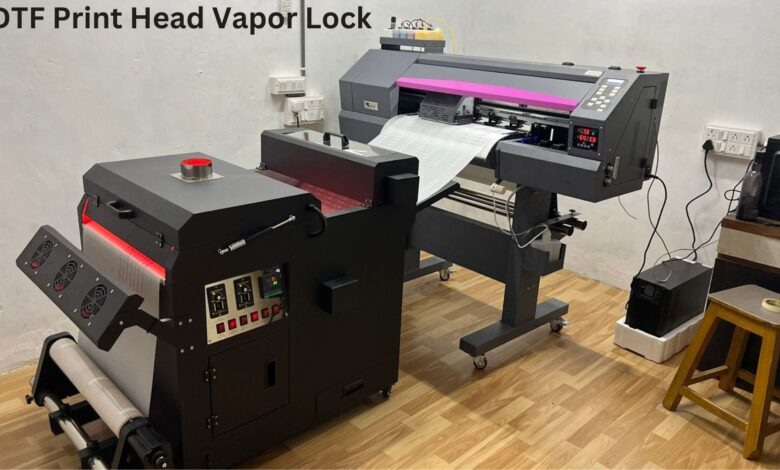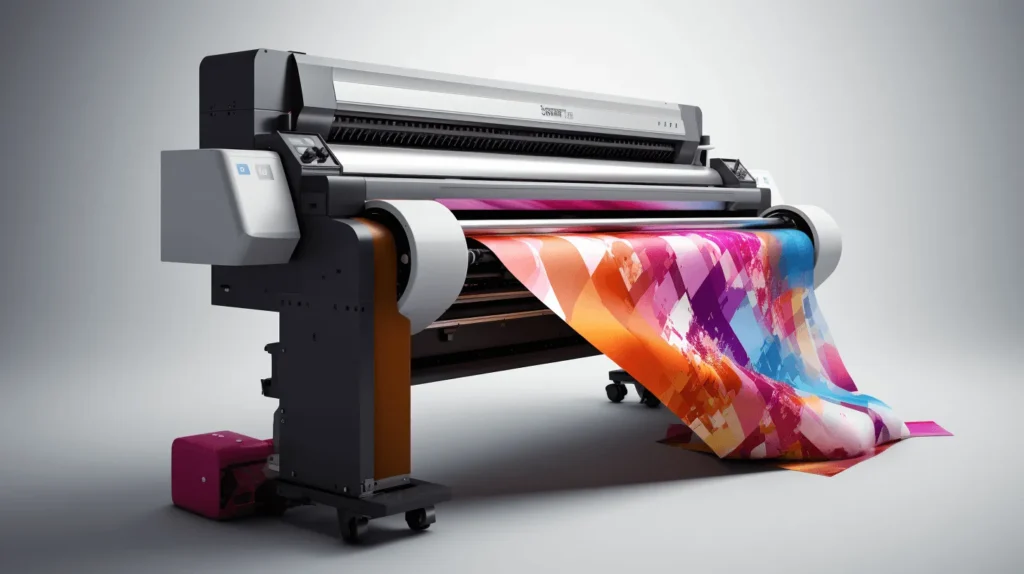Understanding DTF Print Head Vapor Lock Causes, Prevention, and Solutions

Introduction
Direct-to-Film (DTF) printing is a cutting-edge technology that has transformed the textile and custom printing industry. With its ability to print vibrant, detailed designs on a variety of fabrics and other materials, it has become the go-to choice for many print businesses. However, like all printing technologies, DTF Print Head Vapor Lock come with their own set of challenges. One particularly common and troublesome issue is vapor lock in the print head, which can affect print quality and operational efficiency. In this comprehensive article, we will explore what vapor lock is, its causes, prevention methods, and solutions for resolving it effectively.
What is DTF Print Head Vapor Lock?
Vapor lock in DTF printers is a condition that occurs when air bubbles become trapped in the ink system, particularly within the print head. This situation disrupts the consistent flow of ink from the cartridges to the print head, leading to issues like inconsistent prints, streaks, or even complete blockage of the nozzles. Vapor lock is a critical issue because DTF printing relies on precise ink delivery to achieve high-quality prints, and any disruption in the flow of ink can result in poor output and potential downtime.
In essence, vapor lock can significantly hinder the performance of the printer, making it crucial for operators to understand the problem and know how to deal with it effectively.
Also read: Gmrqordyfltk
Causes of Vapor Lock in DTF Printers
To fully understand how DTF Print Head Vapor Lock occurs, it’s essential to identify the root causes behind it. Various factors can contribute to vapor lock in DTF print heads, ranging from issues in the ink system to environmental factors. Below are some of the most common causes:
Air Infiltration in the Ink System
One of the primary causes of vapor lock is air entering the ink system. The ink system of a DTF printer typically includes cartridges, reservoirs, and tubing that carry ink to the print head. If any of these components are not sealed properly or have small leaks, air can infiltrate the system. This creates air bubbles that can get trapped in the ink lines, preventing the ink from flowing smoothly. Over time, these air bubbles can cause vapor lock, leading to inconsistent printing.
Ink Properties and Quality
The quality of the ink used in a DTF printer is another significant factor that contributes to vapor lock. Low-quality or incompatible inks are more likely to foam, leading to the formation of air bubbles. These bubbles can easily become trapped in the ink delivery system. Inks that are overly thick or have high viscosity can also cause clogging and disrupt the normal ink flow, increasing the chances of vapor lock. To avoid these problems, it’s crucial to use high-quality inks that are specifically designed for DTF printing.
Temperature Fluctuations
Environmental temperature plays a key role in the formation of DTF Print Head Vapor Lock. Sudden changes in temperature can cause the ink to expand and contract, creating pressure changes within the ink system. When the ink contracts, air can get trapped in the ink lines, leading to the formation of air bubbles. Similarly, if the printer operates in a very hot or cold environment, the ink’s properties may change, making it more susceptible to foaming and air entrapment.
Improper Maintenance and Cleaning
Lack of proper maintenance is another cause of vapor lock in DTF printers. Over time, ink can dry and build up inside the print head, leading to clogs and air pockets. Failure to perform regular cleaning cycles can leave these blockages in place, allowing air to accumulate in the system. Additionally, if nozzles are not cleaned regularly, they can become clogged with dried ink, further exacerbating the problem.
Incorrect Printer Setup
An improperly set-up printer can also contribute to vapor lock. Issues like incorrect ink feed pressure, improper ink tank filling, or incorrect calibration can lead to inconsistent ink delivery. When the ink flow is disrupted, air can become trapped in the system, leading to vapor lock. Ensuring that the printer is properly set up and calibrated is essential to prevent these issues.
How DTF Print Head Vapor Lock Printing
Understanding the impact of vapor lock is key to realizing the importance of addressing the issue promptly. The most noticeable effects of vapor lock on DTF printing include:
Inconsistent Print Quality
Vapor lock disrupts the smooth flow of ink to the print head, which can result in inconsistent printing. This can lead to visible streaks, uneven color application, or missing details in the print. Since DTF printing is often used for high-quality, detailed designs, any inconsistency in print quality can be highly detrimental to the final product.
Blocked Nozzles and Ink Flow
When air bubbles are trapped in the ink system, they can eventually cause complete blockage of the print head nozzles. This is because the ink can no longer reach the nozzles in the required quantity, or the air prevents the ink from flowing properly. In severe cases, this can cause the printer to stop working entirely until the issue is resolved.
Increased Downtime and Ink Wastage
DTF Print Head Vapor Lock can cause significant downtime, as the printer may need to be stopped for maintenance or troubleshooting. This can lead to delays in production, particularly if the issue is not identified and addressed promptly. Additionally, excessive ink wastage may occur if attempts are made to force the printer to operate despite the vapor lock.
Preventing Vapor Lock in DTF Printers
Prevention is always the best course of action when it comes to vapor lock. Taking proactive steps to minimize the chances of vapor lock occurring will not only improve print quality but also extend the lifespan of the printer. Here are some key strategies to prevent vapor lock:
Use High-Quality Inks
Using high-quality, DTF Print Head Vapor Lock inks is crucial for preventing vapor lock. These inks are specially formulated to minimize foaming and air entrapment. Opting for inks from reputable manufacturers can significantly reduce the chances of encountering vapor lock.
Ensure Proper Sealing of Ink Components
To prevent air from entering the system, ensure that all ink cartridges, reservoirs, and tubing connections are tightly sealed. Check for any loose fittings or damaged seals and replace them as necessary. Regularly inspect the ink system for leaks or cracks and repair them immediately to prevent air from infiltrating the system.
Maintain a Stable Environment
Keep the printer in a temperature-controlled environment with stable humidity levels. Sudden temperature fluctuations can cause the ink to expand or contract, leading to vapor lock. It’s recommended to operate DTF printers in an environment where the temperature remains within a range of 18–24°C (64–75°F) for optimal performance.
Perform Regular Maintenance
Regular cleaning and maintenance are essential for preventing DTF Print Head Vapor Lock. Make sure to perform cleaning cycles as recommended by the manufacturer to keep the ink system free from clogs and residue. Additionally, flush the print head periodically to ensure that no ink or air bubbles remain trapped in the system.
Check Ink Levels and Feed Pressure
Maintaining the correct ink levels is crucial to prevent air from entering the system. Ensure that the ink tanks are not allowed to run dry, as this can introduce air into the lines. Additionally, check that the ink feed pressure is within the optimal range to maintain consistent ink flow.

Solutions for Resolving DTF Print Head Vapor Lock
Despite taking preventive measures, vapor lock can still occur. If you encounter this issue, there are several ways to resolve it effectively:
Run the Print Head Cleaning Cycle
Most DTF printers come equipped with an automatic cleaning cycle designed to remove blockages and air bubbles from the print head. Running this cycle can help clear vapor lock and restore normal ink flow. Make sure to follow the manufacturer’s instructions for running the cleaning cycle to avoid causing further damage.
Manually Flush the Print Head
If the automatic cleaning cycle does not resolve the problem, you may need to manually flush the print head. Use a syringe or specialized cleaning tool to gently flush the print head with cleaning solution. This will help dislodge any trapped air or ink residue and restore ink flow.
Prime the Ink System
Priming the ink system is another effective way to eliminate vapor lock. This process involves forcing ink through the system under controlled pressure, pushing out any air bubbles. Most DTF Print Head Vapor Lock have a priming function, but if yours does not, you can manually prime the system by following the manufacturer’s instructions.
Use a Degassing System
A degassing system can help remove any dissolved gases from the ink before it enters the print head. These systems are particularly useful if you are working with large batches of ink or using inks that are prone to foaming. Installing a degassing system can significantly reduce the likelihood of vapor lock occurring in the first place.
Inspect and Replace Components
If vapor lock persists despite your best efforts, inspect the ink system components for damage. Check the ink cartridges, tubing, and print head for cracks, leaks, or blockages. If any part of the system is compromised, it may need to be replaced to restore normal ink flow.
Consult a Technician
If you’re unable to resolve the issue on your own, it may be time to consult a professional technician. A technician with experience in DTF Print Head Vapor Lock can diagnose the problem and perform more advanced troubleshooting to get the printer back to optimal performance.
Conclusion
DTF Print Head Vapor Lock is a common but manageable issue that can significantly affect print quality and operational efficiency. By understanding the causes of vapor lock and implementing effective preventive measures, you can minimize the chances of encountering this issue in the first place. Regular maintenance, the use of high-quality inks, and ensuring proper printer setup are key to preventing vapor lock. If the problem does occur, running cleaning cycles, flushing the system, and priming the ink lines are effective solutions to restore normal operation. By staying proactive and addressing vapor lock promptly, you can ensure smooth and consistent printing performance, leading to better-quality prints and more efficient production.





